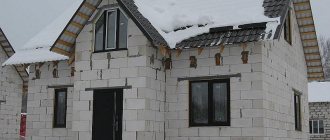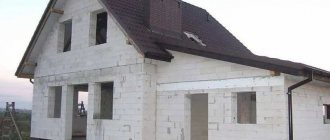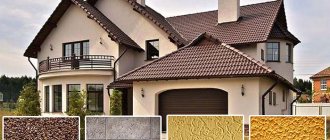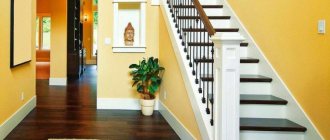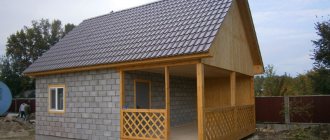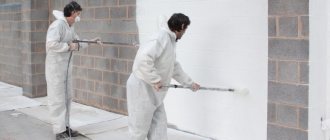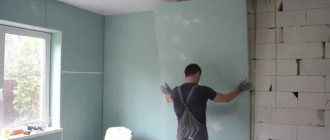In modern suburban construction, foam concrete blocks are used with enviable regularity. The material has many attractive qualities - it is durable, easy to process and cheap. Foam blocks have low thermal conductivity (comparable to wood) and are large in size, which significantly speeds up construction.
Unfortunately, the foam concrete facade cannot be called attractive. But, even if you are a fan of rough, natural surfaces, it is better not to leave foam concrete walls without cladding. Exterior decoration of a house made of foam blocks is not only a way to decorate the structure, but also a vital measure that extends its service life.
A house made of foam blocks without cladding has an unsightly appearance Source ufa.kp.ru
Features of foam concrete blocks
To choose the right facing material, you need to understand what features foam concrete has:
- Structure . The material belongs to the group of cellular concrete and has a fine-porous structure formed by closed (not communicating with each other) air cells. The cells are the result of introducing a foaming agent into the initial cement-sand mixture.
- Attitude to moisture . Due to its structure, foam concrete has low water permeability (when compared with aerated concrete, the pores of which form a network of connected channels). Vapor permeability is the same for all cellular concrete, as it is based on the diffusion of water vapor (water molecules are able to overcome the thickness of concrete; this equalizes the concentration of water vapor indoors and outdoors).
The low water permeability of foam concrete is due to the isolation of the cells Source neoenerg.ru
- Finishing requirements . Since a wall made of foam blocks is capable of breathing (regulating the humidity in the room), any finishing of such a facade must have the main property of not preventing the escape of water vapor. Exterior finishing that does not fulfill this condition will trigger the mechanism of surface destruction (accumulated moisture will freeze in winter, damaging the structure of the cells), and increased humidity will be felt in the house.
Why are foam blocks in great demand in the construction industry?
Foam concrete is successfully used in many areas of construction. It is used for the construction of not only cottage and country houses, but also garages, warehouse complexes, as well as various industrial and commercial structures (workshops, workshops, etc.). The popularity of this material is due to the fact that the façade cellular block has numerous advantages:
- Ease. Foam block weighs much less than brick, monolithic slabs, natural stone and other materials that are often used for the construction of low-rise residential buildings. Therefore, it is much easier to work with, easier to transport by truck and deliver directly to the construction site.
- Porous structure. Facade cellular foam block has a porous internal structure. Thanks to this, the walls of the building “breathe”, thereby ensuring comfortable indoor air humidity.
- Effective thermal insulation. In terms of thermal insulation properties, the façade foam block is noticeably superior to brick, stone and other building materials. Buildings built from such material maintain a warm and cozy environment in winter. Owners do not have to install powerful heating systems and spend a lot of money on heating the premises. In summer, the foam block creates a cool microclimate in the house, which, in turn, eliminates the need to install expensive air conditioners.
- Durability. Since foam concrete is not subject to rotting and does not deteriorate due to changes in humidity or temperature, buildings made from such material remain in perfect condition for many decades. During its entire service life, the building will not require major repairs. It is enough only from time to time (as necessary) to carry out minor cosmetic repairs if any defects arise on the facade.
Properties of exterior finishing of housing made of foam concrete blocks
When deciding how to clad the outside of a house made of foam blocks, pay attention to the performance properties of the facing materials. In addition to the obvious qualities expected in materials for facade finishing work - decorativeness, strength and resistance to solar radiation, they must have additional characteristics:
- Vapor permeability . The main property if your cottage is built from foam concrete blocks. Improperly organized external decoration of a house made of foam blocks will disrupt the regulation of humidity inside the house.
The vapor-permeable properties of the finish do not impair its decorative effect Source materialexpert.ru
- Waterproof . Any finishing material (this is one of its purposes) must protect the structure from the vagaries of the weather.
- Frost resistance . Ability to withstand a sufficient number of freeze-thaw cycles without deterioration in performance.
Foam blocks and their technical characteristics
Let's consider the material parameters:
- Thermal conductivity – 0.14 – 0.22. Based on the coefficient, they judge how well the material maintains temperature. Foam blocks confidently occupy a leading position in the building materials market;
- Strength (grade) – from B1.5. Strength is closely related to the density of the product, and the denser the block, the stronger it is;
- Density – 300 – 1200;
- Frost resistance – 15 – 100. 15 is the minimum species required by GOST. The indicator indicates how many freeze-thaw cycles the material can withstand;
- Shrinkage – from 0.5 mm/m2. Based on this, foam blocks shrink, so it is very important to carry out construction correctly, otherwise even on the finished wall there is a possibility of a crack forming;
- Water absorption – 10 – 16%. Although the blocks will absorb moisture, they will not absorb as much as similar products. This is due to the fact that the pores of the blocks have a closed structure. For example, the same figure for gas blocks is 25%. Despite this, during the construction of a house or cottage it is still recommended to use protection from moisture, since water can affect the strength and, as a result, the service life of the material;
- Environmental friendliness – 2. Products are made from natural ingredients, without the use of harmful or toxic substances;
- Fire resistance. Foam blocks are materials that are resistant to combustion. Can withstand high temperatures for 2 hours without any problems;
- The thickness of the wall is 6 meters. We recommend this indicator, but it is also worth taking into account cold bridges and low temperatures in some regions of the country. For this reason, it is recommended to build walls 1 meter thick.
Based on the technical characteristics, we can draw a conclusion about the material itself, but you also need to take into account that foam blocks come in several types and are used for many tasks. Only knowing complete information can a conclusion be made about the competitiveness of the product.
As for the use of the material in construction, more and more attention has been paid to it recently. For the reason that foam blocks with a facing side do not require cladding - this simplifies the work and reduces construction time.
Acceptable options for cladding a foam block facade
Acceptable methods that take into account the characteristics of foam concrete are:
- Installation of a ventilated facade (installation of suspended cladding). The cladding is fixed to the sheathing, and a small technical gap is created between it and the wall. Most often, vinyl siding, fiber cement boards, corrugated sheets or hanging cassettes are attached to the sheathing.
- Brick cladding . Decorative brick, facade stone or tiles do not interfere with air circulation if an air gap is left between them and the wall.
Cladding a foam block cottage with decorative bricks Source kamtehnopark.ru
- Finishing with plaster . For foam concrete facades, plaster mixtures of a special composition are produced that do not impede air exchange.
- Painting . The walls are painted with silicone paints with increased vapor permeability. The surface of the facade is pre-plastered, and the seams between the blocks are rubbed.
Expanded clay wall block with decorative facade - characteristics and features
The article was written with the help of specialists from the Innoblock company
Despite the boom in frame and wooden house construction in recent years, stone houses are not losing ground, with the difference that today the brick classics have a lot of alternatives. These include varieties of monolithic housing construction, various cement-based blocks, and composite materials. Relatively recently, another promising wall category has appeared on the market - large-porous expanded clay blocks with a decorative facade. Let’s figure out what kind of material this is and how to work with it with the help of specialists from the Innoblock company.
Content
- What are expanded clay blocks with a decorative facade?
- Raw material base and production technology.
- Block characteristics.
- Features of application.
Ventilated facades
This method of wall decoration was developed in post-war Germany. The ventilated facade system includes a supporting frame, which is made of plastic, wood or a metal profile (aluminium, galvanized or stainless steel), and cladding materials fixed on top. Finishing a house made of foam blocks from the outside using a ventilated facade solves several problems:
- Effective removal of water vapor from walls.
- Insulation . A mandatory measure for a house being built in the northern region, since a standard wall made of foam blocks (block thickness 20-30 cm) does not provide sufficient energy savings.
- Protection from natural factors.
- Aesthetic appearance of the facade.
Diagram of a ventilated facade Source sk-pba.ru
Cassette curtain facade
Facade cassettes are produced on a hydraulic CNC bending press; the manufacturing material is stainless or galvanized steel, aluminum or copper. Cassettes have a wide range of colors, but are rarely used in private construction, significantly losing in cost to other facing materials.
Siding in the decoration of a country house
Finishing a house made of foam blocks with siding is the simplest solution, economical and therefore popular. The material boasts a significant selection of colors and textures, which greatly facilitates the decoration of the facade. There are various types of siding on sale: aluminum, fiber cement, porcelain stoneware, composite, vinyl. Vinyl siding is very popular among developers because it has an optimal price-quality ratio and important advantages:
- Resistant to ultraviolet radiation , due to which it retains its original appearance after long-term use (20-25 years).
- Suitable for cladding buildings with a light foundation .
Finishing siding to look like a log on a house made of foam blocks Source stroyportal.ru
See also: Catalog of projects of houses made of foam concrete blocks presented at the exhibition “Low-Rise Country”.
- Easy and quick installation .
- Excellent water repellent properties.
- Resistant to corrosion and temperature changes.
- Easy surface care - dust and dirt are easily washed off with water from a garden hose.
The main disadvantage of vinyl siding is its increased fragility at low temperatures; during frost it can crack from minor (including wind) load.
Finishing the facade with corrugated sheets (profiled sheets)
Corrugated sheeting is widely used as cladding for country buildings made of foam blocks. The material is produced in the form of steel sheets with a complex comb-shaped profile. The industry produces corrugated sheets with decorative and protective coatings of two types:
- Tsinkov . A practical and inexpensive option, which is used for facade decoration and also as a roofing covering.
- Polymer . Thanks to a large number of colors and textures, such corrugated sheeting allows you to give the facade an individual appearance.
Facade lined with wood-like corrugated sheets Source market.sakh.com
A ventilated facade made of corrugated sheets has useful performance characteristics:
- Resistant to the vagaries of weather and all types of corrosion.
- Tightness . Load-bearing walls made of foam blocks will be reliably protected from moisture.
- Durable and easy to maintain. Corrugated sheeting does not require additional processing (lining, for example, requires periodic treatment with an antiseptic and painting).
- Fire resistance . Corrugated sheeting does not support combustion.
What kind of material and what types are there?
Foam block is a material for the production of which natural components are used, which is why in some countries it is called “bioblocks”. Foam concrete is an environmentally friendly building material, safe for both humans and the environment. Initially, the material was created with the aim of combining the qualities of wood and mineral, while remaining artificial. It was first invented by a Swedish architect at the beginning of the 20th century, but foam blocks are still in demand today, as they have excellent performance characteristics. Foam block is an inexpensive, durable, economical, biologically stable and environmentally friendly building material, which, compared to natural wood, does not rot, does not burn and is more durable.
The advantage of foam concrete is that it can be easily covered (upholstered with clapboard, plastered, covered with facade paints, and so on). Foam blocks will not burn or spread combustion, and when in contact with high temperatures (for example, a blowtorch), the surface will not split or explode, as is the case with heavy concrete.
Types of facade foam blocks:
- Simple. Foam blocks with a finished facade are widely used in the construction of summer houses and cottages. This is due to the advantage that when constructing walls, the latter does not require cladding. The outer sides of the materials are factory-coated with high-quality finishing, resulting in a neat and attractive façade. Such cladding not only improves the appearance of the house, but also protects it from external influences (an indicator of resistance to moisture);
- Angular. Compared to a conventional façade block, the product is characterized by two adjacent decorative surfaces. With the help of such foam blocks, door, window openings and corners are lined;
- Thermoblock. The main distinguishing feature is the design. The material is “assembled” from several layers. The front side of the block is a façade cladding to improve visual characteristics. Next comes a thick layer - a heat-insulating filler, which allows you to reduce the thermal conductivity of the material. The inner side is equipped with a load-bearing layer, the task of which is to make the block durable and resistant to physical influences. If thermal insulation material is needed, then a foam block with cladding and insulation is one of the best options. For comparison, a 4-meter wall made of thermal block is identical in thermal insulation characteristics to a 2.4-meter wall made of brick, or a 4.6-meter wall made of concrete. The material is also used to fill the walls of structures that require thermal insulation.
Video description
About finishing a cottage made of foam blocks with siding in the following video:
See also: Catalog of companies that specialize in the construction of turnkey houses.
Fiber cement boards (panels)
The main component of the panels is cement (80 - 90%), it is supplemented with cellulose and mineral additives. Due to its strength and environmental friendliness, this material is in demand when organizing protective finishing of facades. The basis for the slabs is a frame made of metal profiles or wooden slats; water vapor evaporates through the gap. The advantages of fiber cement boards are:
- mechanical strength and non-flammability;
- moisture resistance and frost resistance (3 times higher than brick);
- effective protection from weather influences , increasing the service life of wall structures;
- increasing the heat and sound insulation of the building.
Facade protection with fiber cement Source emupauto.ru
Block house
A blockhouse (a board that imitates timber or logs) allows you to create an environmentally friendly exterior cladding for your home, a common option for a ventilated façade. Blockhouse cladding needs periodic updating: the wood is impregnated with antiseptic and fire retardant every 3-4 years.
Materials for interior finishing
When choosing options for interior wall decoration, we focus on vapor permeability and moisture-repellent properties. From the premises, the foam block is also subject to negative influences. For internal cladding choose:
- Plaster - will help level the surface, release steam to the outside, and keep the foam block dry, even if the wall is watered with a hose. For strength, a reinforcing mesh is used. In the future, the plaster will be decorated with wallpaper or paint.
- Wooden lining. As you know, wood perfectly transmits steam and at the same time can protect the outer wall. The main disadvantage is the need to regularly renew the protective layer of varnish or paint. The lining is installed on the frame, which allows for an additional ventilated gap to remove vapors.
- Drywall is also a good option for leveling interior walls, especially if you plan to make complex structures. I install the material with adhesive or frame, depending on what scope of work is planned to be done next. After installation, the drywall is puttied and painted or decorated with wallpaper.
Foam block is an excellent material for the rapid construction of residential buildings, but at the same time it requires a protective coating. If this is not done, then in a decade the walls will begin to collapse, and strengthening them is much more difficult and expensive than taking care of high-quality cladding at the beginning.
Cladding with heavy materials
If you are against the use of polymer materials in exterior finishing, then you can use another technology. Exterior finishing of a house made of foam blocks with heavy materials (stone, brick or tile) is more labor-intensive and difficult to perform, but has its advantages. The decision to finish with stone is made at the design stage, since in this case the foundation will need to be laid with a 15-20 cm release around the perimeter of the house.
The cladding with the selected facing material is carried out simultaneously with the laying of the façade wall made of foam blocks. Under the finishing layer, insulation (most often mineral wool) with a windproof membrane is fixed. An air gap remains between the film and the foam block masonry; Metal anchors are used to attach the cladding to the facade.
Wall blocks made of expanded clay - raw material base, production technology
The main component of the blocks is expanded clay - light porous granules obtained from sedimentary clayey rocks (low-melting, with a quartz content of no more than 30%). During the firing process, clay prepared in a special way swells, forming granules of different densities and fractions.
Solid expanded clay blocks are produced using vibration casting technology from expanded clay and a cement binder - during the mixing process, the solution envelops each granule like a batter, forming capsules with a very strong crust. It is not for nothing that it is believed that everything new is a well-forgotten old - the technique for producing encapsulated expanded clay concrete was developed back in the 60s of the last century. It was classified as a large-porous lightweight concrete, and we were talking specifically about concrete with solid expanded clay (expanded clay crushed stone).
The inner layer of an expanded clay block made of expanded clay concrete (fine-grained), and the outer layer, with a decorative stone-like surface, are molded simultaneously with the load-bearing one. The solution for artificial stone is painted in bulk using imported dyes, resulting in a uniform color that is resistant to external influences. The gamma corresponds to the shades of natural stone species, so the finished walls do not need additional painting.
Video description
About laying facing bricks in the following video:
Facing brick
Brick allows you to do without installing a suspended ventilated system and plastering external walls. Single and thickened, as well as clinker (increased strength) material is available. The obvious advantages of brick are:
- Strength and durability . Brick grades from M75 to M250 are produced. Resistance to precipitation is achieved due to the low porosity of the material (6-14%).
- Frost resistance . An important parameter for areas with cold and long winters. Bricks with grades from F25 to F75 are available for sale.
- Variety . Wide range of textures and colors. The cladding uses red, yellow, white and brick with various shades of brown. The front surface can have a depressed relief, be glazed (coated with a composition based on glass powder and then fired) or engobed (coated with liquid colored clay and re-fired).
- Environmental friendliness . Natural clay is used in the production of bricks.
The disadvantages of brick cladding are labor-intensive and costly.
Brick cladding is carried out simultaneously with the construction of walls Source samodelkino.info
Types of foam blocks with decorative coating
Facade decorative block with cladding comes in several types:
- Simple. A simple wall foam block with a finished facade has become widespread in the field of country and cottage construction. Its main advantage is that after the walls are erected there is no need to carry out facing work. The outer surfaces of the blocks are initially covered with a layer of high-quality finishing, making the façade look beautiful and respectable. The facing coating applied to the front side of each block not only gives the materials excellent aesthetic qualities, but also protects it from external influences (since it has a high degree of moisture resistance).
- Angular. Unlike a conventional facade block, this material has two adjacent decorative surfaces. It is used for arranging door and window openings and finishing corners.
- Thermoblock. Structurally, such blocks consist of several layers. On the front side of the material
There is a facing facade layer that gives the foam block an aesthetic appearance. Behind it is a thick layer of heat-insulating filler designed to reduce the thermal conductivity of the blocks. On the inside there is a load-bearing layer, which gives the building material sufficient strength and resistance to mechanical loads. Thermoblock is one of the best thermal insulating materials. Thus, a 0.4 m thick thermoblock wall is identical in thermal insulation quality to a 2.4 m brick or 4.6 m concrete wall. Therefore, it is often used to fill the walls of buildings that require effective thermal insulation.
Video description
About the intricacies of applying plaster to a foam block facade in the following video:
Facade finishing with tiles
Cladding a house made of foam blocks with tiles does not require strengthening the foundation, as it is done directly on the facade, using a special mixture. Clinker tiles, porcelain tiles and frost-resistant ceramic tiles are used to decorate walls.
All materials provide reliable protection for foam block walls, and their appearance is varied. In the external design they use both colored tiles and imitating ceramic bricks or natural stone. Despite the aesthetics and cheapness, tiles should be used with caution (for partial cladding) - foam concrete removes moisture to the outside; this destroys the mixture that holds the cladding together.
Production of textured blocks
For the production of decorative foam concrete, special automated lines, universal forms, original facing mixtures and painting methods are used.
- A solution is mixed from sand, cement and special foam.
- The mixture is poured into molds.
- Place on a vibrating table and vibrate to distribute air evenly.
- Leave until completely hardened.
- The finished foam block is lowered into a mold with a decorative mixture and again placed on a vibrating table, where the textured layer fuses with the surface of the block through the process of diffusion.
- Double processing of products helps to harden the surface and improve the adhesion of the decorative mixture.
Today, the invention of universal mold equipment makes it possible to reduce the manufacturing time of products by pouring foam blocks in one stage, which significantly reduces the cost of the material.
Some manufacturers are producing a completely new type of facade foam block with the front side covered with artificial stone. This cladding reliably covers the structure of cellular concrete from moisture penetration.
Foam blocks with a finished facade
A wall thickness of no more than 0.45 m can preserve all the important parameters of foam concrete, such as sound absorption, thermal insulation, and reliability.
Decorative foam blocks can be used to construct not only walls, but also internal partitions, fences, and foundations. A building made of cellular concrete will not require a powerful foundation, as it is a lightweight building. In addition, there is no need to create a multi-layer wall structure, which also reduces the cost of construction.
The blocks are available in two modifications:
- Facade – for walls and partitions (they have one textured surface).
- Corner – for finishing corners, wall and door openings (they have two adjacent decorative surfaces).
The variety of textured layers allows you to decorate the walls of a house with imitation stone, marble, brick, wood, and a wide palette of colors will help you choose a shade to suit any architectural style.
Color palette of decorative foam blocks
When building walls, the same instructions apply as for simple foam concrete - the blocks are placed on a special glue, laid in a thin layer. The verticality and horizontality of the masonry is strictly observed, otherwise the flaws cannot be hidden behind additional cladding.
Combining different textures on the facade will turn your house into an original and sophisticated masterpiece of architecture.
Modern methods of painting facade foam concrete make the cladding wear-resistant, capable of resisting environmental influences and negative atmospheric phenomena for a long time. A house built from decorative foam concrete will always look stylish and modern.
The video in this article will clearly show the benefits of using this unique building material.
Plaster and paints for exterior finishing
Cladding a foam block country house with plaster is a quick and inexpensive way to protect the facade. The plaster is quickly applied and dries, has a presentable appearance and is perfectly combined with other facing materials (for example, with artificial stone for the base).
Decorative finishing of the facade with plaster Source yandex.ru
What cannot be used for cladding walls with foam concrete
Exterior finishing cannot be done with materials that prevent the diffusion of water vapor. Their use will result in moisture being retained on the façade surface; thermal conductivity (and heating bills) will increase, and the strength of the facade will decrease. Not suitable for external cladding:
- thin slabs of foamed polymers;
- use of concrete and ceramic tiles;
- classic cement-sand mortar;
- ordinary paints that create a film on the surface that is impenetrable to vapor.
The construction technology of foam concrete provides for the protection of the material from contact with water or snow, so even a house with the correct cladding needs additional protection:
- Proper installation of the roof and drainage system .
- Organization of window sill drains and canopies over the decorative details of the facade.
- Protect the base from moisture.
Combined cladding of a country cottage made of foam blocks Source yandex.uz
Application area
Many people are interested in where decorative foam blocks can be used.
The main purpose is the external cladding of houses, as well as buildings constructed from other materials.
For example, if the construction was carried out using brick, wood or ordinary building foam blocks, the exterior finishing can be applied based on decorative blocks.
Sometimes the material is used in the construction of interior partitions. They do not need to be further trimmed or decorated. Optimal for loft style.
Yes, the facing foam block can be replaced with brick for cladding. But the price of such material is much higher. So consumers often choose foam blocks.
